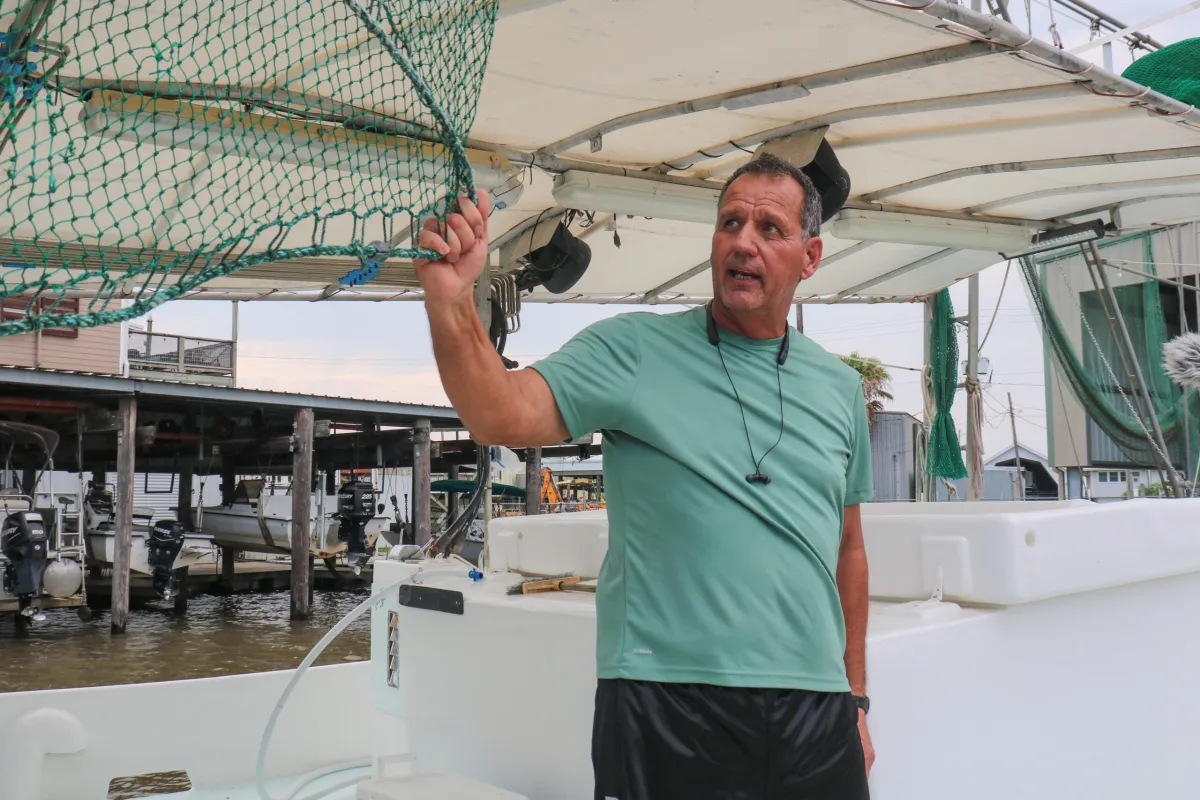Farm to Trouble, Part 2 of 5 — “At the mouth of the Mississippi, Louisiana bears the burden of upstream runoff. Why doesn’t it push for solutions?”
This story is the second in a five-part series being shared by MSSC with permission called “Farm to Trouble,” a collaborative investigative reporting effort led by AG & Water Desk. The series takes a deep dive into the slow progress to reduce the polluted runoff from agriculture and other industries into the Mississippi River. This runoff from 31 states flows into the Gulf of Mexico and has created a “dead zone” off Louisiana’s western coast and threatens to make the Mississippi Sound a dead zone in the future.
By Delaney Dryfoos, The Lens, June 18, 2024

CYPREMORT POINT, La. — Thomas Olander has watched his shrimp-catch shrink over the last 15 years. It’s not just a lesser abundance of Louisiana shrimp; Olander said that the average size of the crustacean has also shrunk.
In the past, shrimpers could expect the crustaceans to grow throughout the spring season, which starts in May in Louisiana waters and generally runs through July. “Since we’ve been dealing with this ‘dead zone,’” said Olander. “We’re not seeing that growth no more.
”The dead zone is a stretch along the shallows of the Gulf of Mexico where algae blooms choke off oxygen in the water.
This month, the National Oceanic and Atmospheric Administration (NOAA) estimated that this summer’s dead zone would reach 5,827 square miles – an area roughly the size of Connecticut. That’s up from approximately 3,058 square miles in 2023.
These massive algae blooms are caused by nutrients that run off of farms up and down the Mississippi River Basin, which stretches from Northern Minnesota to the Gulf of Mexico.
Fertilizer that helps crops grow contains high levels of nitrogen and phosphorus. These nutrients run off the fields during rainstorms at the end of the growing season and end up in waterways leading to the Mississippi River.
In 1996, the dead zone in the Gulf of Mexico came to national attention through local reporting. The Gulf of Mexico Hypoxia Task Force – a collaboration of state, federal and tribal agencies – was established in the fall of 1997 and asked to create and implement an action plan.
A preliminary goal is to reduce both nitrogen and phosphorus by 20% by 2025. But despite some progress, the task force has not yet met its goals.
The U.S. Geological Survey showed that in May 2024, while nitrogen loads in the lower Mississippi River were 7% lower than baseline measurements, phosphorus loads increased by 22%.
The 2025 target is simply not a priority for the task force, said Doug Daigle, a research scientist at Louisiana State University and coordinator of the Louisiana Hypoxia Working Group. He added that neither the task force nor Louisiana attempted to raise funds from Congress to implement programs that would reduce nutrient pollution.
“It’s a problem with the task force, not just Louisiana. There has not been an organized attempt to garner more funding for the action plan,” said Daigle.
To read part one of this series, click HERE.
“Farm to Trouble” Credits:
Contributing reporters & news outlets: Erin Jordan, The Gazette (Iowa); Delaney Dryfoos, The Lens (New Orleans); Madeline Heim, Milwaukee Journal Sentinel; Bennet Goldstein, Wisconsin Watch; Eric Schmid, St. Louis Public Radio; Joy Mazur, Columbia Missourian (Missouri); and Connor Giffin, Louisville Courier Journal (Kentucky).
Lead editors: Tegan Wendland, Ag & Water Desk; Erin Jordan, The Gazette; Kelly McEvers, host of NPR’s Embedded podcast
Data visualizations: Jared Whalen, data journalist, Ag & Water Desk
The Ag & Water Desk receives major funding from the Walton Family Foundation, which also funds many organizations within our region. The Desk retains full editorial independence. Please contact info@agwaterdesk.org with any questions.
Organizations referenced in this series that have also received Walton funding: Ducks Unlimited, Tulane University, Gulf Restoration Network, The Nature Conservancy, Louisiana Department of Agriculture and Forestry, University of Iowa, University of Minnesota, Minnesota Center for Environmental Advocacy, Iowa Environmental Council, Practical Farmers of Iowa, Precision Conservation Management, and Lighthawk.